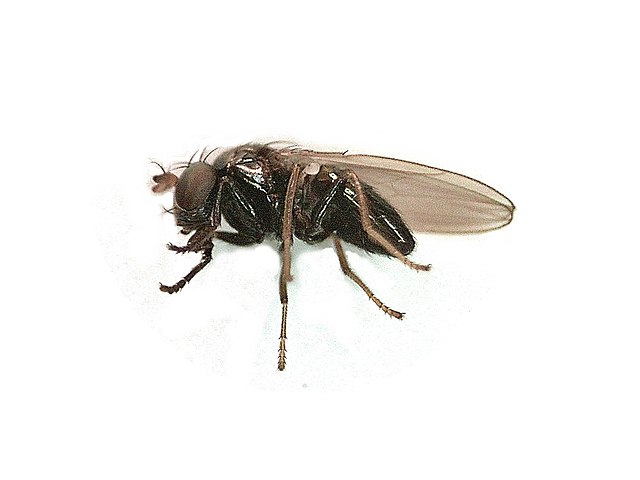Invasion History
First Non-native North American Tidal Record:First Non-native West Coast Tidal Record:
First Non-native East/Gulf Coast Tidal Record:
General Invasion History:
Fifteen species of shore flies (Ephydridae) are known from the Galapagos. Two species are apparently introductions, previously absent in the East Pacific. The remaining species are widespread in the Neotropics (Mathis 1995).
The shore fly Hecamede brasiliensis was described from Rio de Janeiro, State, Brazil, in 1938. It is distributed on both coasts of the tropical Atlantic, from Belize and the West Indies to Brazil, and in Cameroon and Nigeria. The occurrence in Belize (1989, Mathis 1993), may represent a recent invasion since it was not found by Mathis in previous sampling. This fly is also found in the oceanic islands of St. Helena and Ascension (Mathis 1993). It appears to be cryptogenic on both sides of the Atlantic since its native region is not clear.
North American Invasion History:
Invasion History Elsewhere in the World:
Invasion History Elsewhere in the World is not summarized for this species at this time.
Description
The shore fly Hecamede brasiliensis is one of a family of small flies that breed in saline waters, shoreline debris, and shallow fresh to hypersaline, organically rich water. The adult flies usually stay near water or shores, in low emergent or shoreline vegetation. Hecamede brasiliensis has a nondescript typical fly-like appearance, gray to brown in color, with lighter legs and wings, 1.60–2.65 mm long (Mathis 1994).
Taxonomy
Taxonomic Tree
| Kingdom: | Animalia | |
| Phylum: | Arthropoda | |
| Subphylum: | Hexapoda | |
| Class: | Insecta | |
| Subclass: | Pterygota | |
| Superorder: | Neoptera | |
| Order: | Diptera | |
| Suborder: | Brachycera | |
| Infraorder: | Muscomorpha | |
| Family: | Ephydridae | |
| Species: | brasiliensis |
Synonyms
Potentially Misidentified Species
Ecology
General:
Shore flies (Ephyridae) are small flies that usually occur near water or wetlands, often in saline conditions. Larvae are typical small maggots which may develop in water, wet soil, or vegetation. Hecamede brasiliensis is usually found near mangrove debris (Mathis 1994). Adults are associated with dead fishes, crabs, and decaying vegetation (Mathis 1993). In the Galapagos Islands, it was found on saline soil, or mangrove debris (Peck et al. 1998). Adults usually do not fly far from water (Simpson 1976).
Food:
Algae; dead fish, crabs, decaying vegeation
Trophic Status:
Suspension Feeder
SusFedHabitats
| General Habitat | Unstructured Bottom | None |
| General Habitat | Salt-brackish marsh | None |
| General Habitat | Nontidal Freshwater | None |
| General Habitat | Swamp | None |
| General Habitat | Mangroves | None |
| General Habitat | Terrestrial | None |
| General Habitat | Coarse Woody Debris | None |
| Salinity Range | Limnetic | 0-0.5 PSU |
| Salinity Range | Oligohaline | 0.5-5 PSU |
| Salinity Range | Mesohaline | 5-18 PSU |
| Salinity Range | Polyhaline | 18-30 PSU |
| Tidal Range | Low Intertidal | None |
| Tidal Range | Mid Intertidal | None |
| Tidal Range | High Intertidal | None |
| Tidal Range | Supratidal | None |
| Vertical Habitat | Epibenthic | None |
Life History
Tolerances and Life History Parameters
| Minimum Length (mm) | 1.6 | None |
| Maximum Length (mm) | 2.6 | None |
| Broad Temperature Range | None | Tropical |
| Broad Salinity Range | None | Polyhaline-Euhaline |
General Impacts
Impacts are unknown.
Regional Distribution Map
Non-native
Native
Cryptogenic
Failed
Occurrence Map
References
Carlton, James T.; Keith, Inti; Ruiz, Gregory M. (2019) Assessing marine bioinvasions in the Galápagos Islands: implications for conservation biology and marine protected areas, Aquatic Invasions 14(1): 1-20Mathis, Wayne N. (1993) Studies of Gymnomyzinae (Diptera: Ephydridae), IV: A Revision of the shore-fly Genus Hecamede Haliday, Smithsonian Contributions to Zoology 541: 1-46
Mathis, Wayne N. (1995) Shore files of the Galapagos Islands, Annals of the Entomological Society of America 66(5): 627-640
Peck, Stewart B.; Heraty, John; Landry, Bernard; Sinclair, Bradley J. (1998) Introduced insect fauna of an oceanic archipelago: The Galapagos Islands, Ecuador, American Entomologist 44: 218-237
